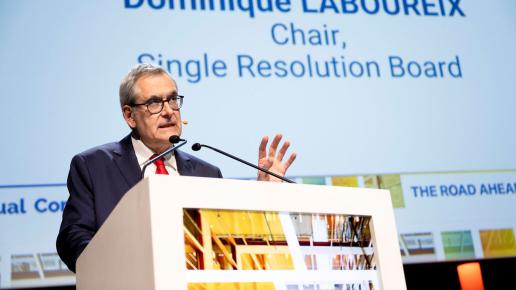As the mandate of the current European Commission and Parliament draws to an end, it is worth reflecting on the progress made, as well as the priorities on the resolution framework for the next EU legislature.
From the perspective of the Single Resolution Board (SRB), the finalisation of the Banking Package represents a milestone in further strengthening the framework. The partial harmonisation of the creditor hierarchy was another step forward. Building on these achievements, the SRB is hopeful that the next legislature will deliver on the implementation, review and completion of the resolution framework.
The lingering asymmetries between the EU resolution regime and national insolvency frameworks are one of the areas where further progress is needed. The problems are well known and the SRB, as well as other authorities, academics and the industry, have made their case more than once.
To recall, the assessment of the no-creditor-worse-off principle (comparing the treatment of creditors in resolution to the one they would have received under insolvency proceedings) is complicated by the co-existence of nineteen different insolvency frameworks in the Banking Union. This results in diverging outcomes depending on where a bank entity is located.
Moreover, the conditions to determine that a bank is ‘failing or likely to fail’ are not necessarily aligned to the criteria for liquidation at national level, which also poses challenges.
Furthermore, the requirements for burden sharing under the European Commission’s 2013 Banking Communication, which apply in cases of precautionary recapitalisation and liquidation aid, are not entirely in line with those for bail-in under the Bank Recovery and Resolution Directive (BRRD) and the Single Resolution Mechanism Regulation (SRMR), potentially giving wrong incentives when compared to resolution.
Finally, the ranking of creditors in insolvency was only partially harmonised: Directive 2017/2399 focused only on unsecured debt instruments in the hierarchy, while national differences remain on the ranking of the rest of the creditors, leading also to divergences in the protection of creditors and uneven loss absorption.
In the next mandate, legislators could focus on these issues to complete the framework. This could be done gradually: the review of Directive 2017/2399 could be an opportunity to fully harmonise the creditor hierarchy, while BRRD/SRMR and the 2013 Banking Communication could be revised to align incentives and close the gaps between the EU resolution framework and the insolvency rules for banks. In this sense, the set up and experience of the Federal Deposit Insurance Corporation in the US offers a number of lessons, as recently highlighted by a study from the European Parliament Think Tank.
It is not only authorities and credit institutions – particularly the ones less likely to pass the public interest test and therefore be resolved – that would gain from a common and upgraded insolvency regime. Investors and creditors (including households) would also greatly benefit from a stable underlying legal framework that provides the same degree of certainty in liquidation as in resolution.
It is often emphasised that deepening the EU’s Economic and Monetary Union requires the completion of the Banking Union and of the Capital Markets Union. A common framework for banks’ insolvency would constitute a significant advance on both paths. In turn, both the Banking Union and a strong, truly European capital market can play an important role in the creation of the needed liquidity for capital instruments and MREL. Therefore, work on those files must continue to progress in the new EU legislature.
- Read the Eurofi Magazine from April 2019 | Bucharest
Contact our communications team
Recent interviews

The president of the SRB acknowledges that the fund that led to resolution by the Spanish bank in 2017 has progressed a lot since then and that...

Cypriot banks are on track to meeting their MREL targets, set by the Single Resolution Board (SRB) even well before their deadline, SRB chair...

In the past, some small and middle-sized banks fell between the cracks of the resolution framework. Resolution authorities were not able to resolve...



